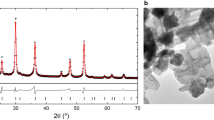Abstract
A fundamental assumption of palaeomagnetism is that rocks can provide a reliable record of the Earth's magnetic field. It is known that as magnetic minerals undergo chemical change they acquire a form of chemical remanent magnetization (CRM)1. Indeed, the magnetic phases formed at different times in the history of the rock may add several components of CRM to its net magnetization2, so that a valid application of palaeomagnetism to the interpretation of geological history requires a knowledge of the different components of CRM and the time of their acquisition. There are two mechanisms responsible for CRM3: mineral alteration and crystal growth. To understand the properties and acquisition mechanisms of CRM associated with the growth of mineral crystals, which is known as grain-growth CRM4, we have developed a technique for the synthesis of haematite crystals under controlled conditions. We find that the acquired magnetization is parallel to the applied magnetic field.
This is a preview of subscription content, access via your institution
Access options
Subscribe to this journal
Receive 51 print issues and online access
$199.00 per year
only $3.90 per issue
Buy this article
- Purchase on Springer Link
- Instant access to full article PDF
Prices may be subject to local taxes which are calculated during checkout
Similar content being viewed by others
References
1. Stacey, F. D. & Banerjee, S. K. The Physical Principles of Rock Magnetism (Elsevier, New York, 1974). 2. Larson, E. E. & Walker, T. R. Geol. Soc. Am. Bull. 86, 639–650 (1975). 3. Haigh, G. Phil Mag. 3, 267–286 (1958). 4. Kobayashi, K. /. Geomagn. Geoelect. 12, 148–163 (1961). 5. Kobayashi, K. /. Geomagn. Geoelect. 10, 99–117 (1959). 6. Greenwalt, D. thesis, MIT, Cambridge, Massachusetts (1960). 7. Hedley, I. G. Phys. Earth planet. Int. 1, 103–121 (1968). 8. Amerigian, C. Geol. Soc. Am. Abstr. Progm. 10, 358 (1978). 9. Marshall, M. & Cox, A. Nature 230, 28–31 (1971). 10. Johnson, H. P. & Merrill, R. T. / geophys. Res. 79, 5533–5534 (1974). 11. Bailey, M. & Hale, C. J. Nature 294, 739–741 (1981). 12. Henshaw, P. C. Jr & Merrill, R. T. Rev. Geophys. Space Phys. 18, 483–504 (1980). 13. Towe, K. M. & Bradley, W. F. / Colloid Interface Sci. 24, 384–392 (1967). 14. Merrill, R. T. & McElhinny, M. W. The Earth's Magnetic Field (Academic, New York, 1983). 15. Tauxe, L. & Kent, D. Geophys. J. R. astr. Soc. 77, 543–561 (1984). 16. Neel, L. Ann. Geophys. 5, 99–136 (1949). 17. Channell, J. E. T. et al. Earth planet. Sci. Lett. 58, 189–201 (1982). 18. Banerjee, S. Nature phys. Sci. 232, 15–16 (1971). 19. Banerjee, S. Phil Mag. 8, 119–120 (1963). 20. Flanders, P. J. & Schuele, W. J. Phil. Mag. 9, 485–490 (1964). 21. Pullaiah, G. et al. Earth planet. Sci. Lett. 28, 133–143 (1975). 22. Kirschvinck, J. Geophys. J. R. astr. Soc. 62, 699–718 (1980).
Author information
Authors and Affiliations
Rights and permissions
About this article
Cite this article
Stokking, L., Tauxe, L. Acquisition of chemical remanent magnetization by synthetic iron oxide. Nature 327, 610–612 (1987). https://doi.org/10.1038/327610a0
Received:
Accepted:
Issue Date:
DOI: https://doi.org/10.1038/327610a0
This article is cited by
-
Control of Earth-like magnetic fields on the transformation of ferrihydrite to hematite and goethite
Scientific Reports (2016)
Comments
By submitting a comment you agree to abide by our Terms and Community Guidelines. If you find something abusive or that does not comply with our terms or guidelines please flag it as inappropriate.



